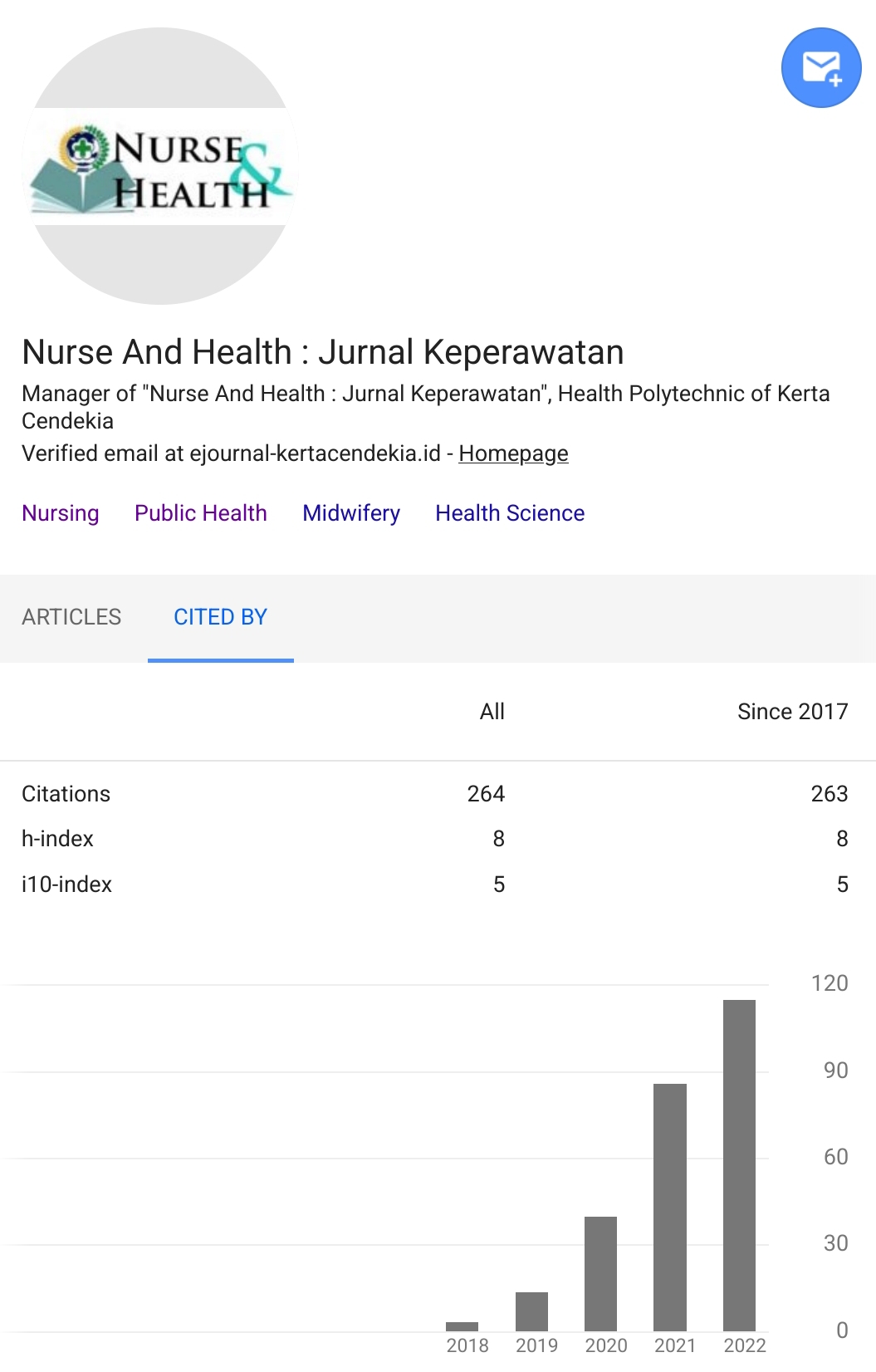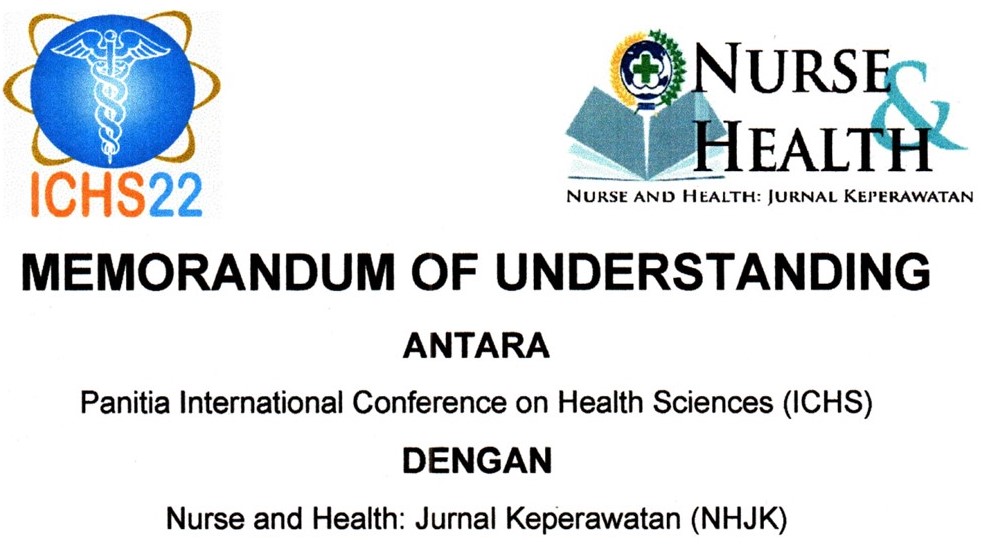IDENTIFICATION OF KEY FACTORS TO IMPROVE NURSES' TRIAGE COMPETENCE IN HOSPITALS: A SCOPING REVIEW
Abstract
Background: Many emergency department nurses still lack adequate competency in performing triage, so hospital management needs to understand the right strategies to enhance triage competencies. Objective: The purpose of this scoping review is to identify and analyze the essential factors contributing to the improvement of nurses' triage competencies in hospitals. Methods: This scoping review was conducted by identifying scientific articles in five databases: ScienceDirect, ProQuest, Google Scholar, Wiley Online Library, and Springer Link. The authors used the keywords "emergency nurses" AND "triage competency" AND "emergency department." After identification, the authors selected and analyzed articles using PRISMA based on predefined inclusion and exclusion criteria. Studies obtained from various databases yielded 186 research articles, and from this number, 10 relevant articles were extracted for data analysis. Results: Ten studies were included in this scoping review, and the most important factor in improving triage competency was participating in triage training, providing innovative triage learning methods, and developing nurses' professional self-concept. This review shows that the most effective effort is to provide triage training, as it covers all triage related material in depth by applying various learning methods aligned with actual practice.Conclusion: This review found that triage training is the most effective factor in improving nurses' triage competency in hospitals.Downloads
References
Adriaenssens, J., De Gucht, V., & Maes, S. (2015). Causes and consequences of occupational stress in emergency nurses, a longitudinal study. Journal of Nursing Management, 23(3), 346–358. https://doi.org/10.1111/jonm.12138 DOI: https://doi.org/10.1111/jonm.12138
Aghababaeian, H., Araghi Ahvazi, L., Moosavi, A., Ahmadi Mazhin, S., Tahery, N., Nouri, M., Kiarsi, M., & Kalani, L. (2019). Triage live lecture versus triage video podcast in pre-hospital students’ education. African Journal of Emergency Medicine, 9(2), 81–86. https://doi.org/10.1016/J.AFJEM.2018.12.001 DOI: https://doi.org/10.1016/j.afjem.2018.12.001
Aloyce, R., Leshabari, S., & Brysiewicz, P. (2014). Assessment Of Knowledge And Skills Of Triage Amongst Nurses Working In The Emergency Centres In Dar Es Salaam, Tanzania. African Journal of Emergency Medicine, 4(1), 14–18. https://doi.org/10.1016/j.afjem.2013.04.009 DOI: https://doi.org/10.1016/j.afjem.2013.04.009
Ariyani, H., & Rosidawati, I. (2020). LITERATURE REVIEW: PENGGUNAAN TRIASE EMERGENCY SEVERITY INDEX (ESI) DI INSTALASI GAWAT DARURAT (IGD). Jurnal Kesehatan Bakti Tunas Husada: Jurnal Ilmu-Ilmu Keperawatan, Analis Kesehatan Dan Farmasi, 20(2), Article 2. DOI: https://doi.org/10.36465/jkbth.v20i2.606
Arthur, D. (1995). Measurement of the professional self-concept of nurses: Developing a measurement instrument. Nurse Education Today, 15(5), 328–335. https://doi.org/10.1016/S0260-6917(95)80004-2 DOI: https://doi.org/10.1016/S0260-6917(95)80004-2
Butler, K., Anderson, N., & Jull, A. (2023a). Evaluating the effects of triage education on triage accuracy within the emergency department: An integrative review. International Emergency Nursing, 70, 101322. https://doi.org/10.1016/j.ienj.2023.101322
Butler, K., Anderson, N., & Jull, A. (2023b). Evaluating the effects of triage education on triage accuracy within the emergency department: An integrative review. International Emergency Nursing, 70. https://doi.org/10.1016/j.ienj.2023.101322 DOI: https://doi.org/10.1016/j.ienj.2023.101322
Cho, Y.-J., Han, Y.-R., & Jeong, Y.-W. (2022). Professional Self-Concept, Job Stress, and Triage Competency Among Emergency Nurses: Secondary Data Analysis of a Cross-Sectional Survey. Journal of Emergency Nursing, 48(3), 288–298. https://doi.org/10.1016/j.jen.2022.01.010 DOI: https://doi.org/10.1016/j.jen.2022.01.010
Chow, K. M. (2023). Is high-fidelity simulation-based training in emergency nursing effective in enhancing clinical decision-making skills? A mixed methods study. Nurse Education in Practice. DOI: https://doi.org/10.1016/j.nepr.2023.103610
Currie, J., Kourouche, S., Gordon, C., Jorm, C., & West, S. (2018). Mass casualty education for undergraduate nursing students in Australia. Nurse Education in Practice, 28, 156–162. https://doi.org/10.1016/J.NEPR.2017.10.006 DOI: https://doi.org/10.1016/j.nepr.2017.10.006
Gilboy, N., Tanabe, P., Travers, D., & Rosenau, A. (2020). ESI implementation handbook 2020. Emergency Nurses Association.
Goniewicz, K., Goniewicz, M., Burkle, F. M., & Khorram-Manesh, A. (2021). Cohort research analysis of disaster experience, preparedness, and competency-based training among nurses. PLOS ONE, 16(1), e0244488. https://doi.org/10.1371/journal.pone.0244488 DOI: https://doi.org/10.1371/journal.pone.0244488
Hung, C.-C., Kao, H.-F. S., Liu, H.-C., Liang, H.-F., Chu, T.-P., & Lee, B.-O. (2021). Effects of simulation-based learning on nursing students’ perceived competence, self-efficacy, and learning satisfaction: A repeat measurement method. Nurse Education Today, 97, 104725. https://doi.org/10.1016/j.nedt.2020.104725 DOI: https://doi.org/10.1016/j.nedt.2020.104725
Hwang, S., & Shin, S. (2022). Factors affecting triage competence among emergency room nurses: A cross‐sectional study. Journal of Nursing Management, 32(13–14). https://doi.org/10.1111/jocn.16441
Hwang, S., & Shin, S. (2023). Factors affecting triage competence among emergency room nurses: A cross-sectional study. Journal of Clinical Nursing, 32(13–14), 3589–3598. https://doi.org/10.1111/jocn.16441 DOI: https://doi.org/10.1111/jocn.16441
Jahromi, Z. B., Kargar, M., & Ramezanli, S. (2015). Study of the Relationship Between Nurse Self-Concept and Clinical Performance Among Nursing Students. Jentashapir Journal of Health Research, 6(5), Article 5. https://doi.org/10.17795/jjhr-28108 DOI: https://doi.org/10.17795/jjhr-28108
Javadi, M., Gheshlaghi, M., & Bijani, M. (2023). A comparison between the impacts of lecturing and flipped classrooms in virtual learning on triage nurses ’ knowledge and professional capability: An experimental study. BMC Nursing, 1–11. https://doi.org/10.1186/s12912-023-01353-2 DOI: https://doi.org/10.1186/s12912-023-01353-2
Kenyon, S., Hewison, A., Dann, S.-A., Easterbrook, J., Hamilton-Giachritsis, C., Beckmann, A., & Johns, N. (2017). The design and implementation of an obstetric triage system for unscheduled pregnancy related attendances: A mixed methods evaluation. BMC Pregnancy and Childbirth, 17(1), 309. https://doi.org/10.1186/s12884-017-1503-5 DOI: https://doi.org/10.1186/s12884-017-1503-5
Lee, H. I., & Park, J. S. (2020). The Effect of Pre-operative Information through Audiovisual Media on Self-Care Knowledge, Self-Efficacy, and State Anxiety of Patients before Bariatric Surgery. Korean Journal of Adult Nursing, 32(4), 421–431. DOI: https://doi.org/10.7475/kjan.2020.32.4.421
McCarthy, M. F., Pollock, W. E., & McDonald, S. J. (2022). Implementation of an obstetric triage decision aid into a maternity assessment unit and emergency department. Women and Birth, 35(3), e275–e285. https://doi.org/10.1016/j.wombi.2021.06.001 DOI: https://doi.org/10.1016/j.wombi.2021.06.001
Mohan, D., Farris, C., Fischhoff, B., Rosengart, M. R., Angus, D. C., Yealy, D. M., Wallace, D. J., & Barnato, A. E. (2017). Efficacy of educational video game versus traditional educational apps at improving physician decision making in trauma triage: Randomized controlled trial. BMJ, j5416. https://doi.org/10.1136/bmj.j5416 DOI: https://doi.org/10.1136/bmj.j5416
Moon, S. H., & Park, Y. H. (2017). Concept Analysis of Triage Competency in Emergency Nursing. Journal of Korean Critical Care Nursing, 10(3), 41–52.
Moon, S.-H., & Cho, I. Y. (2024). Development of a Competency-Based Triage Education Application and Usability Testing for Triage Training Based on the Korean Triage and Acuity Scale. The Journal of Continuing Education in Nursing, 55(1), 33–41. https://doi.org/10.3928/00220124-20231030-05 DOI: https://doi.org/10.3928/00220124-20231030-05
Moon, S.-H., & Cho, I.-Y. (2022). The Effect of Competency-Based Triage Education Application on Emergency Nurses’ Triage Competency and Performance. Healthcare, 10(4), Article 4. https://doi.org/10.3390/healthcare10040596 DOI: https://doi.org/10.3390/healthcare10040596
Moon, S.-H., & Kim, S. O. (2024). Enhancing triage accuracy in emergency nurses: The impact of a game-based triage educational app. International Emergency Nursing, 72, 101398. https://doi.org/10.1016/j.ienj.2023.101398 DOI: https://doi.org/10.1016/j.ienj.2023.101398
Najafi, Z., Abbaszadeh, A., Zakeri, H., & Mirhaghi, A. (2019). Determination of mis-triage in trauma patients: A systematic review. European Journal of Trauma and Emergency Surgery, 45(5), 821–839. https://doi.org/10.1007/s00068-019-01097-2 DOI: https://doi.org/10.1007/s00068-019-01097-2
Nowak, M. J. J. FitzpatrickC. K. S. (2015). Community partnerships: Teaching volunteerism , emergency preparedness and awarding red cross certificates in nursing school curricula . Procedia - Social and Behavioral Sciences, 174, 331–337. https://doi.org/10.1016/j.sbspro.2015.01.669 DOI: https://doi.org/10.1016/j.sbspro.2015.01.669
Oh, W.-O., & Jung, M.-J. (2024). Triage—clinical reasoning on emergency nursing competency: A multiple linear mediation effect. BMC Nursing, 23(1), 274. https://doi.org/10.1186/s12912-024-01919-8 DOI: https://doi.org/10.1186/s12912-024-01919-8
Park, Y. J., Kong, E.-H., & Park, Y. A. (2018). Triage Nurses’ Work Experiences in Emergency Department: A Qualitative Research. Journal of muscle and joint health, 25(3), 176–186. https://doi.org/10.5953/JMJH.2018.25.3.176
Putranta, H. (2018). MODEL PEMBELAJARAN KELOMPOK SISTEM PERILAKU: BEHAVIOR SYSTEM GROUP LEARNING MODEL. Universitas Negeri Yogyakarta.
Robson, K., Plangger, K., Kietzmann, J. H., McCarthy, I., & Pitt, L. (2015). Is it all a game? Understanding the principles of gamification. Business Horizons, 58(4), 411–420. https://doi.org/10.1016/j.bushor.2015.03.006 DOI: https://doi.org/10.1016/j.bushor.2015.03.006
RSCM. (2023). Kurikulum Pelatihan Triase Proaktif Bagi Dokter, Perawat Dan Bidan Di Instalasi Gawat Darurat Rumah Sakit. IGD RSUP Nasional Dr. Cipto Mangunkusumo.
Rumampuk, J., & Katuuk, M. E. (2019). HUBUNGAN KETEPATAN TRIASE DENGAN RESPONSE TIME PERAWAT DI INSTALASI GAWAT DARURAT RUMAH SAKIT TIPE C. JURNAL KEPERAWATAN, 7(1). https://doi.org/10.35790/jkp.v7i1.25206 DOI: https://doi.org/10.35790/jkp.v7i1.25206
Rustiawati, E., & Dewi, N. H. (2021). PENGARUH PELATIHAN TRIASE TERHADAP PENGETAHUAN PERAWAT DAN BIDAN TENTANG PENERAPAN TRIASE DI UNIT GAWAT DARURAT PUSKESMAS GUNUNG SARI KABUPATEN SERANG. JAWARA (Jurnal Ilmiah Keperawatan), 2(1), 23–28. DOI: https://doi.org/10.59894/jpkk.v2i2.498
Santoso, B. (2010). Skema dan Mekanisme Pelatihan: Panduan Penyelenggaraan Pelatihan. Yayasan Terumbu Karang Indonesia.
Sari, S. R., & Fajarini, M. (2022). The Emergency Severity Index (ESI) Usage: Triage Accuracy and Causes of Mistriage. Jurnal Aisyah : Jurnal Ilmu Kesehatan, 7(S1), Article S1. https://doi.org/10.30604/jika.v7iS1.1190 DOI: https://doi.org/10.30604/jika.v7iS1.1190
Seo, M., Park, J., Kim, O., Heo, M., Park, J., & Park, M. (2017). The Influence of Clinical Nurses’ Professional Self Concept and Interpersonal Relations on Nursing Competence. Korea Journal of Hospital Management, 22(2), 28–43.
Shuk, M., Hung, Y., Kam, S., Lam, K., Chum, M., Chow, M., Wing, W., Ng, M., Pau, O. K., Ruzafa-Martínez, M., García González, J., Zelenikova, R., & Ramos-Morcillo, A. J. (2021). The Effectiveness of Disaster Education for Undergraduate Nursing Students’ Knowledge, Willingness, and Perceived Ability: An Evaluation Study. Public Health, 18, 10545. https://doi.org/10.3390/ijerph181910545 DOI: https://doi.org/10.3390/ijerph181910545
Siallagan, A., Friska Ginting, F., & Manurung, Y. (2021). Konsep Diri Mahasiswa Program Profesi ners di STIKes Santa Elisabeth Medan Tahun 2021 | JINTAN: Jurnal Ilmu Keperawatan. Jurnal Ilmu Keperawatan. https://ojs.unhaj.ac.id/index.php/jintan/article/view/51 DOI: https://doi.org/10.51771/jintan.v1i2.51
Soola, A. H., Mehri, S., & Azizpour, I. (2022). Evaluation of the factors affecting triage decision-making among emergency department nurses and emergency medical technicians in Iran: A study based on Benner’s theory. BMC Emergency Medicine, 22(1), 174. https://doi.org/10.1186/s12873-022-00729-y DOI: https://doi.org/10.1186/s12873-022-00729-y
Stover-Baker, B., Stahlman, B., & Pollack, M. (2012). Triage Nurse Prediction of Hospital Admission. Journal of Emergency Nursing, 38(3), 306–310. https://doi.org/10.1016/j.jen.2011.10.003 DOI: https://doi.org/10.1016/j.jen.2011.10.003
Sung, M. H., & Oh, M. O. (2016). The Relationships of Professional Self-Concept, Role Conflict and Job Satisfaction on Emergency Department Nurses. Journal of Korean Academy of Fundamentals of Nursing, 18(1), 107–115.
Terzioğlu, F., Yücel, Ç., Koç, G., Şimşek, Ş., Yaşar, B. N., Şahan, F. U., Akın, R., Öçal, S. E., Akdağ, C., Elçin, M., Mert, M., & Yıldırım, S. (2016). A new strategy in nursing education: From hybrid simulation to clinical practice. Nurse Education Today, 39, 104–108. https://doi.org/10.1016/j.nedt.2016.01.009 DOI: https://doi.org/10.1016/j.nedt.2016.01.009
Tricco, A. C., Lillie, E., Zarin, W., O’Brien, K. K., Colquhoun, H., Levac, D., Moher, D., Peters, M. D. J., Horsley, T., Weeks, L., Hempel, S., Akl, E. A., Chang, C., McGowan, J., Stewart, L., Hartling, L., Aldcroft, A., Wilson, M. G., Garritty, C., … Straus, S. E. (2018). PRISMA Extension for Scoping Reviews (PRISMA-ScR): Checklist and Explanation. Annals of Internal Medicine, 169(7), 467–473. https://doi.org/10.7326/M18-0850 DOI: https://doi.org/10.7326/M18-0850
Uslu, Y., Kocatepe, V., Unver, V., Sagır, O., Karabacak, U., & Mehmet Ali, A. (2019). Hybrid Simulation in Triage Training. International Journal of Caring Sciences, 12(3), 1626–1637.
Wolf, L., Delao, A., Simon, C., & Jodelka, F. M. (2024). Establishing Triage Competencies and Verification Processes: A Survey Study. Journal of Emergency Nursing. https://doi.org/10.1016/j.jen.2024.09.005 DOI: https://doi.org/10.1016/j.jen.2024.09.005
Yoon, J., & Son, H. (2021). Factors Associated with School Nurses’ Triage Competency in South Korea. International Journal of Environmental Research and Public Health, 18(16), Article 16. https://doi.org/10.3390/ijerph18168279 DOI: https://doi.org/10.3390/ijerph18168279
Yuwanich, N., Sandmark, H., & Akhavan, S. (2016). Emergency department nurses’ experiences of occupational stress: A qualitative study from a public hospital in Bangkok, Thailand. Work, 53(4), 885–897. https://doi.org/10.3233/WOR-152181 DOI: https://doi.org/10.3233/WOR-152181
Zagalioti, S.-C., Fyntanidou, B., Exadaktylos, A., Lallas, K., & Ziaka, M. (2023). The first positive evidence that training improves triage decisions in Greece: Evidence from emergency nurses at an Academic Tertiary Care Emergency Department. BMC Emergency Medicine, 23(1), 60. https://doi.org/10.1186/s12873-023-00827-5. DOI: https://doi.org/10.1186/s12873-023-00827-5
Copyright (c) 2025 Angga Andreas Wantoro

This work is licensed under a Creative Commons Attribution-NonCommercial 4.0 International License.
Authors who publish with Nurse and Health: Jurnal Keperawatan agree to the following terms:
- Authors retain copyright licensed under a Creative Commons Attribution-NonCommercial 4.0 (CC BY-NC 4.0), which allows others to remix, tweak, and build upon the authors' work non-commercially, and although the others' new works must also acknowledge the authors and be non-commercial, they don't have to license their derivative works on the same terms.
- Authors are permitted and encouraged to post their work online (e.g., in institutional repositories or on their website) prior to and during the submission process, as it can lead to productive exchanges, as well as earlier and greater citation of published work (See The Effect of Open Access). Authors can archive pre-print and post-print or publisher's version/PDF.






















